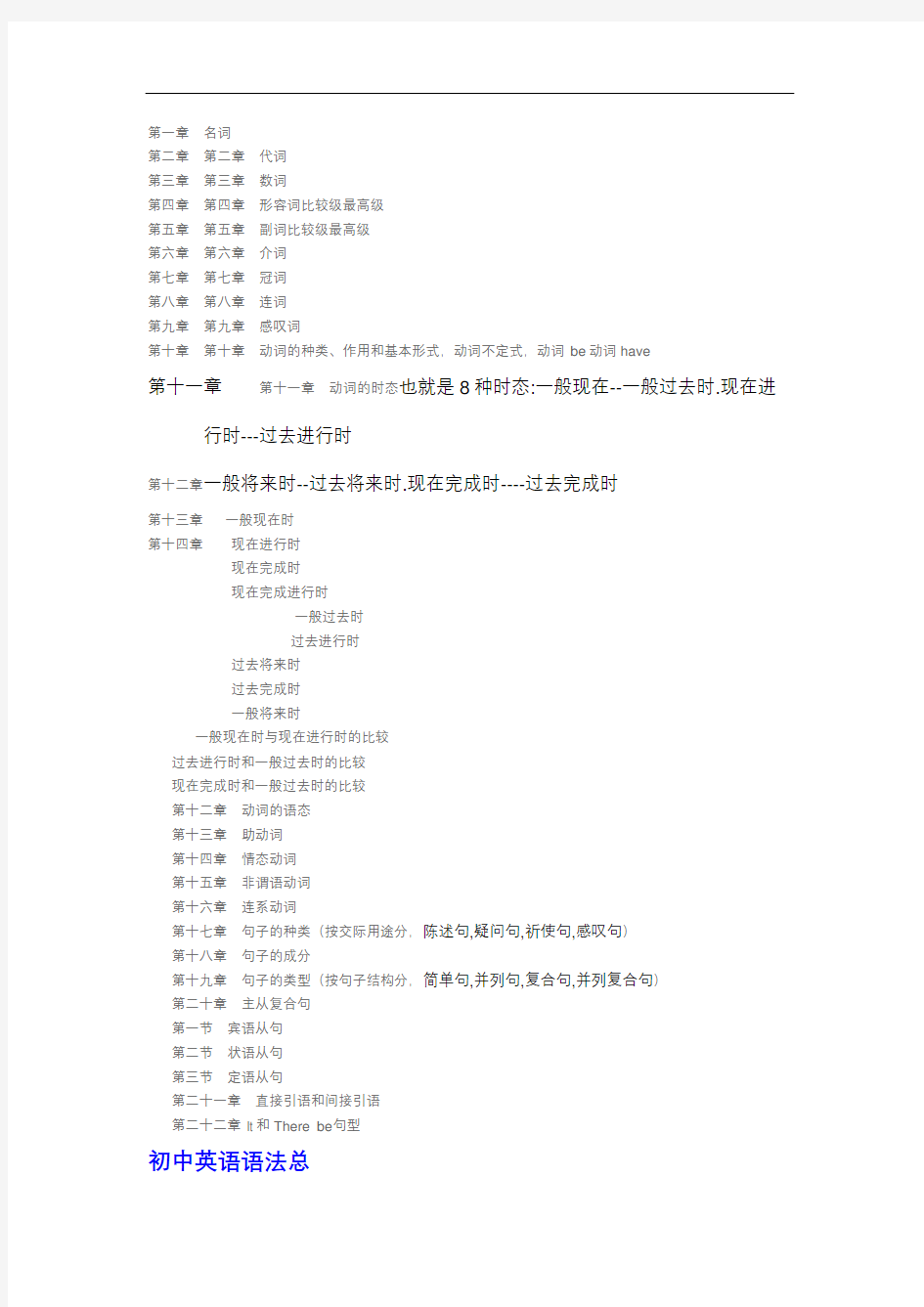初中英语语法大纲


初中英语语法大纲
Company Document number:WTUT-WT88Y-W8BBGB-BWYTT-19998
第一章名词
第二章第二章代词
第三章第三章数词
第四章第四章形容词比较级最高级
第五章第五章副词比较级最高级
第六章第六章介词
第七章第七章冠词
第八章第八章连词
第九章第九章感叹词
第十章第十章动词的种类、作用和基本形式,动词不定式,动词be动词have
第十一章第十一章动词的时态也就是8种时态:一般现在--一般过去时.现在进行时---过去进行时
第十二章一般将来时--过去将来时.现在完成时----过去完成时
第十三章一般现在时
第十四章现在进行时
现在完成时
现在完成进行时
一般过去时
过去进行时
过去将来时
过去完成时
一般将来时
一般现在时与现在进行时的比较
过去进行时和一般过去时的比较
现在完成时和一般过去时的比较
第十二章动词的语态
第十三章助动词
第十四章情态动词
第十五章非谓语动词
第十六章连系动词
第十七章句子的种类(按交际用途分,陈述句,疑问句,祈使句,感叹句)
第十八章句子的成分
第十九章句子的类型(按句子结构分,简单句,并列句,复合句,并列复合句)
第二十章主从复合句
第一节宾语从句
第二节状语从句
第三节定语从句
第二十一章直接引语和间接引语
第二十二章 It和There be句型
初中英语语法总
基本句型一: S V (主+谓)
基本句型二: S V P (主+谓+表)
基本句型三: S V O (主+谓+宾)
基本句型四: S V o O (主+谓+间宾+直宾)
基本句型五; S V O C (主+谓+宾+宾补)
八大时态
一、一般现在时:
1.概念:经常、反复发生的动作或行为及现在的某种状况。
2.时间状语: always, usually, often, sometimes, every week (day, year, mon th…), once a week, on Sundays,
3.基本结构:动词原形(如主语为第三人称单数,动词上要加(e)S)
4.否定形式:am/is/are+not;此时态的谓语动词若为行为动词,则在其前加
don't,如主语为第三人称单数,则用doesn't,同时还原行为动词。
5.一般疑问句:把be动词放于句首;用助动词do提问,如主语为第三人称单数,则用does,同时,还原行为动词。
6.例句:. It seldom snows here.
He is always ready to help others.
Action speaks louder than words.
二、一般过去时:
1.概念:过去某个时间里发生的动作或状态;过去习惯性、经常性的动作、行为。
2.时间状语:ago, yesterday, the day before yesterday, last week(year, night, month…), in 1989, just now, at the age of 5, one day, long long ago, once upon a time, etc.
3.基本结构:be动词;行为动词
4.否定形式:was/were+not;在行为动词前加didn't,同时还原行为动词。
5.一般疑问句:was或were放于句首;用助动词do的过去式did 提问,同时
还原行为动词。
6.例句:She often came to help us in those days.
I didn't know you were so busy.
三、现在进行时:
1.概念:表示现阶段或说话时正在进行的动作及行为。
2.时间状语:now, at this time, these days, etc.
3.基本结构:am/is/are+doing
4.否定形式:am/is/are+not+doing.
5.一般疑问句:把be动词放于句首。
6.例句: How are you feeling today
He is doing well in his lessons.
四、过去进行时:
1.概念:表示过去某段时间或某一时刻正在发生或进行的行为或动作。
2.时间状语:at this time yesterday, at that time或以when引导的谓语
动词是一般过去时的时间状语等。
3.基本结构:was/were+doing
4.否定形式:was/were + not + doing.
5.一般疑问句:把was或were放于句首。
6.例句:At that time she was working in a PLA unit.
When he came in, I was reading a newspaper.
五、现在完成时:
1.概念:过去发生或已经完成的动作对现在造成的影响或结果,或从过去已经
开始,持续到现在的动作或状态。
2.时间状语:recently, lately, since…for…,in the past few years, etc.
3.基本结构:have/has + done
4.否定形式:have/has + not +d one.
5.一般疑问句:have或has。
6.例句:I've written an article.
It has been raining these days.
六、过去完成时:
1.概念:以过去某个时间为标准,在此以前发生的动作或行为,或在过去某动
作之前完成的行为,即“过去的过去”。
2.时间状语:before, by the end o f last year(term, month…),etc.
3.基本结构:had + done.
4.否定形式:had + not + done.
5.一般疑问句:had放于句首。
6.例句:As soon as we got to the station, the train had left.
By the end of last month. We had reviewed four books
七、一般将来时:
1.概念:表示将要发生的动作或存在的状态及打算、计划或准备做某事。
2.时间状语:tomorrow, next day(week, month, year…),soon, in a few minute s, by…,the day after tomorrow, etc.
3.基本结构:am/is/are/going to + do;will/shall + do.
4.否定形式:was/were + not; 在行为动词前加didn't,同时还原行为动词。
5.一般疑问句:be放于句首;will/shall提到句首。
6.例句:They are going to have a competition with us in studies.
It is going to rain.
八、过去将来时:
1.概念:立足于过去某一时刻,从过去看将来,常用于宾语从句中。
2.时间状语:the next day(morning, year…),t he following
month(week…),etc.
3.基本结构:was/were/going to + do;would/should + do.
4.否定形式:was/were/not + going to + do;would/should + not + do.
5.一般疑问句:was或were放于句首;would/should 提到句首。
6.例句:He said he would go to Beijing the next day
初中英语语法视频
1. 动词be
2. 人称代词和物主代词
3. 名词的复数形式
4. 现在进行时态
5. 现在进行时
6. 动词have
7. 一般现在时
8. 基数词和序数词
9. 词类
10. 词类
11. 各种特殊疑问句及其回答
12. 形容词和副词的比较级和最高级
13. 冠词
14. 反身代词
15. 动词的种类
16. 句子的成分
17. 句子的类型
18. 状语从句
19. 疑问句
20. 一般过去时态
21. 一般将来时态
22. 过去进行时态
23. 现在完成时态
24. 动词不定式
25. 宾语从句
